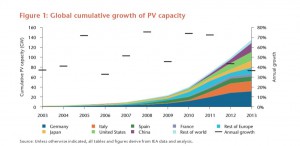 How about some good news for a change? The end of the dominance of the oil age could be sooner than you think.
How about some good news for a change? The end of the dominance of the oil age could be sooner than you think.
According to two reports released yesterday by the world’s energy watchdog, the International Energy Agency, by the middle of this century, the sun could be the world’s largest source of electricity.
The two IEA technology roadmaps published yesterday outlined how by 2050 solar could be beating fossil fuels, wind, hydro and nuclear.
Solar Photovoltaics (PV) are already growing rapidly and has been the fastest-growing renewable energy technology in the world over the last decade: the IEA believes that cumulative PV capacity has grown at just under 50 per cent per year on average since 2003.
Indeed, some 137 GW of solar PV capacity had been installed worldwide by the end of last year and each day another 100 MW is added.
The IEA believes that by mid-century the price of PV is expected to drop by 65 per cent. This means that PV could generate up to 16% of the world’s electricity. Meanwhile solar thermal electricity from concentrating solar power plants, which thrive in hot cloudless deserts, could provide an additional 11%.
Together, these two solar technologies could prevent the emission of a staggering 6 billion tonnes of CO2, more than the current energy-related CO2 emissions from the United States.
The IEA Executive Director Maria van der Hoeven argued yesterday that “The rapid cost decrease of photovoltaic modules and systems in the last few years has opened new perspectives for using solar energy as a major source of electricity in the coming years and decades.”
The IEA was keen to stress that, although the two reports do not represent a forecast, they do outline what policy actions are required to make them a reality, including the need for “clear, credible and consistent signals from policy makers”.
The US and China will be key to the growth in PV, with the need for their governments to offer solar incentives as well as reducing subsidies for fossil fuels.
By 2050, the IEA predicts that over half of total capacity for PV will be situated with consumers, such as households, shopping malls or industries, whereas STE will expand in Africa, India, the Middle East as well as potentially the United States.
Meanwhile back in the present, the FT reports that the US is overtaking Saudi Arabia to become the largest producer of liquid petroleum, and might even be the largest producer of crude oil by the end of the decade.
So for the moment, at least in the US, its still full steam ahead with fossil fuels and fracking. But every day the sun is playing catch up.

Now we need to make the second step, not only must we make the shift, BUT ALL THE WORK MANUFACTURING THE EQUIPMENT AND PARTS NEEDED MUST BE DONE HERE! No labor in foreign countries!